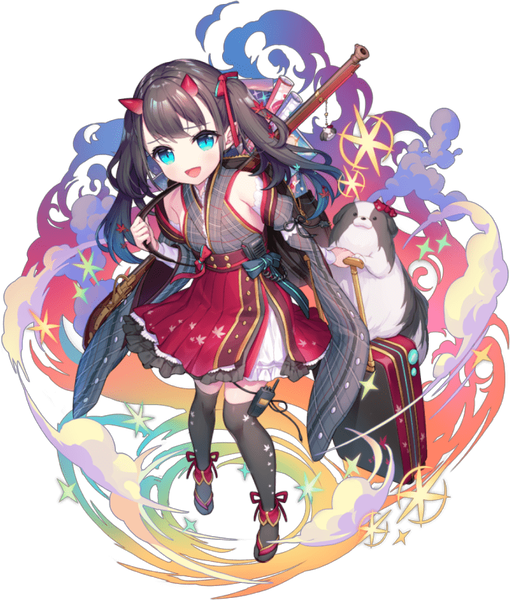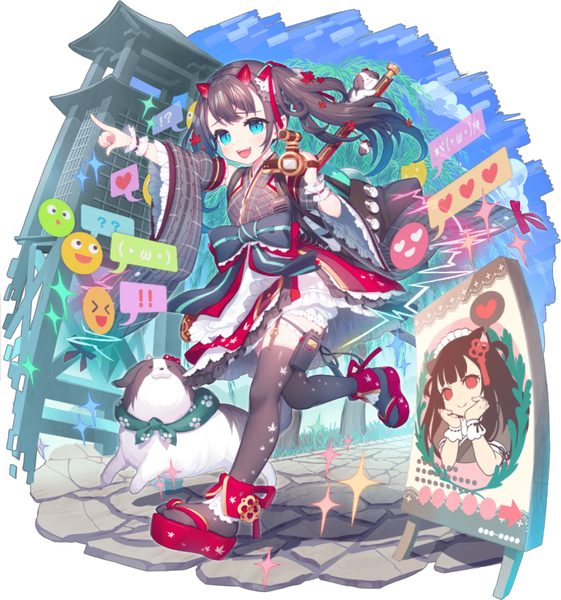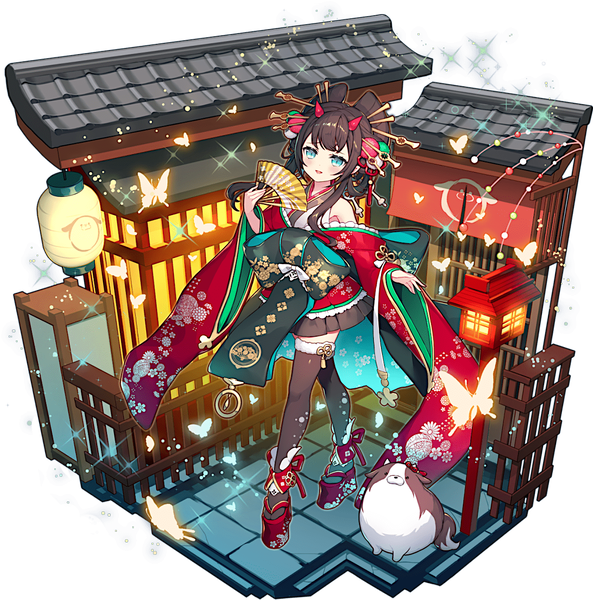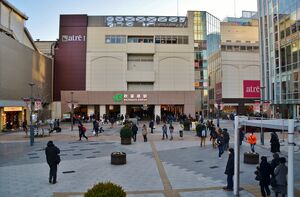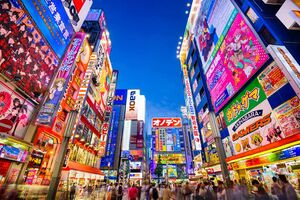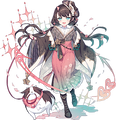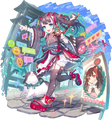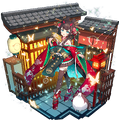Akihabara
| Akihabara | |||||
|---|---|---|---|---|---|
| Japanese Name | アキハバラ | ||||
| Weapon | |||||
| Race | Kijin | ||||
| Nationality | |||||
| Birthday | November 1 | ||||
| Constellation | Scorpio | ||||
| Talents | Sensing impurity | ||||
| Likes | Families (People in red-light districts), Japanese Spaniels | ||||
| Dislikes | Common sense, Etiquette, Fires, Normies | ||||
| Strengths | Able to share her likes without any worry | ||||
| Weaknesses | Doesn't have much common sense | ||||
| Hobbies | Idols, Movies, Manga, Military, etc. | ||||
Akiba scrounges around for junk to repair and shell on the black market. That's how to make my living. Akiba was an abandoned child myself growing up in the slums. But you know, all the people I met down there are so kind. Akiba had so much fun, love them! Akiba's not unhappy at all! There's plenty of loot to find in a heap of junk!
Layers
| Icon | Title | Release Date | Where to Obtain |
|---|---|---|---|
| [Akiba☆Channel] Akihabara | 2022 June 17 (EN) | [The Swaying Phantom Silver Torch Flower] Pick Up Gacha, Premium Gacha | |
| [Otaku Streamer] Akihabara | 2022 February 28 | Mist Train Girls ~ From the Window of the Mist World Novel 2 - Serial Code (DMM Japan) | |
| [High Class Courtesan Akiba's Legend] Akihabara | 2023 April 24 | [Spectacled Librarian and the Master Actress] Limited Gacha | |
| [Searching the City for Content] Akihabara | 2021 September 24 | 1st Anniversary Limited Gacha 2 | |
| [Otaku's Brilliant Dream Story] Akihabara | 2023 November 30 | [Oiran Taisen in Kabukichou] Pick Up Gacha, Premium Gacha |
Owned Skills
Trivia
- Akihabara's birthday is the opening date of Akihabara station, first as a freight station on November 1, 1890, then opened as a passenger station on November 1, 1925.
- Akihabara's dislike of fire is a reference to the Great Fire of Meireki and Akihabara in 1657. After the Meireki fires, a fire extinguisher shrine was built and called Chinkasha (now known as Akiba Shrine (秋葉神社, Akiba Jinja)), meaning fire extinguisher shrine, in an attempt to prevent the spread of future fires.
- Akihabara's species as a kijin is likely a reference to the god Akiha Gongen (秋葉権現) of Akiba Jinja, the deity that could control fire, and the area around it became known as Akibagahara and later Akihabara.
- Akihabara's occupation of collecting junk, reassemble, and resale to the black market is a reference to the state of Akihabara after the Second World War in 1945 - Tokyo Denki University and students came to Akihabara to assemble radios, beginning the electronic black market stores.
- The region of Akihabara is famous for electronics, idols, movies, manga, and anime, which are Akihabara's favourites. However, it was not until the launch of Microsoft Windows 1995 that Akihabara became known as a place for otaku culture.
- A watchtower can be seen in the background of [Searching the City for Content], referencing Akihabara's early history of fire prevention.
- The rifle Akihabara use is a Tanegashima musket, first introduced to Japan in 1543 through the Portuguese Empire, common with samurai class and ashigaru foot soldiers, notably used in Sengoku period. The name was originally from a Japanese island, where the gun was first appeared.
- Akihabara is the first character in the game to have access to all five Elements (Fire, Water, Wind, Dark, Light) for her skills.
Counterpart
Akihabara Station (秋葉原駅) is a railway station in Tokyo's Chiyoda ward. It is at the center of the Akihabara shopping district specializing in electronic goods. Akihabara Station was opened in November 1, 1890 as a freight terminal linked to Ueno Station via tracks following the course of the modern day Yamanote Line.
It was opened to passenger traffic in November 1, 1925 following the construction of the section of track linking Ueno with Shinbashi via Tokyo Station and the completion of the Yamanote Line. The upper level platforms were added in 1932 with the opening of an extension to the Sōbu Line from its old terminal at Ryōgoku to Ochanomizu, making Akihabara an important transfer station for passengers from the east of Tokyo and Chiba Prefecture.
The huge growth in commuter traffic following the Second World War caused considerable congestion and was only relieved with the construction of the Sōbu line tunnel linking Kinshichō with Tokyo, bypassing Akihabara. The Hibiya Line subway station was opened on May 31, 1962, with the line's extension from Naka-Okachimachi to Ningyōchō. The station facilities of the Hibiya Line were inherited by Tokyo Metro after the privatization of the Teito Rapid Transit Authority (TRTA) in 2004.
On August 24, 2005, the underground terminus of the new Tsukuba Express Line opened at Akihabara. The entire station complex, including the JR station, was also refurbished and enlarged in preparation for the opening of the Tsukuba Express. Currently, it is the 11th largest station in JR East line. Wikipedia
The Akihabara area in central Tokyo is well known as a marketplace of technology; it has ties to the Japanese video game industry, as well as to anime and manga publishers.
The influence of otaku culture has shaped Akihabara's businesses and buildings to reflect the interests of otaku and gained the district worldwide fame for its distinctive imagery. Akihabara tries to create an atmosphere as close as possible to the game and anime worlds of customers' interest. The streets of Akihabara are covered with anime and manga icons, and cosplayers line the sidewalks handing out advertisements, especially for maid cafés.
Release events, special events, and conventions in Akihabara give anime and manga fans frequent opportunities to meet the creators of the works they follow and strengthen the connection between the region and otaku culture. The design of many of the buildings serves to create the sort of atmosphere that draws in otaku. Architects design the stores of Akihabara to be more opaque and closed to reflect the general desire of many otaku to live in their anime worlds rather than display their interests to the world at large.
Akihabara's role as a free market has also allowed a large amount of amateur work to find a passionate audience in the otaku who frequent the area. Doujinshi (amateur or fanmade manga based on an anime/manga/game) has been growing in Akihabara since the 1970s when publishers began to drop manga that were not ready for large markets. Comiket is largest spot sale of Doujinshi in Japan. Wikipedia
Map
Gallery
- Pages using Tabber parser tag
- Pages using DynamicPageList3 parser tag
- Weapon Gun
- Kijin
- Nishiki
- Scorpio
- Element Pierce
- Element Fire
- Element Dark
- Element Wind
- Element Light
- Element Water
- Train Knights
- Japan


